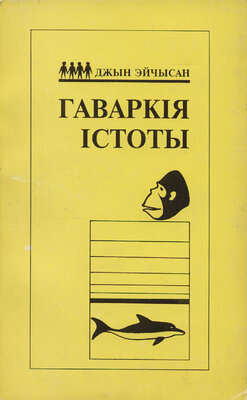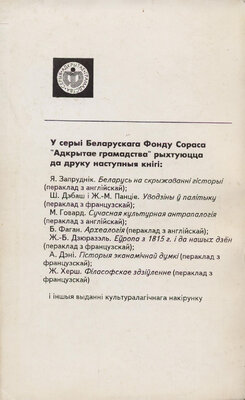Гаваркія істоты
Уводзіны ў псіхалінгвістыку
Джын Эйчысан
Выдавец: Беларускі Фонд Сораса
Памер: 220с.
Мінск 1995
Раздзел 10,
Успрыманне мовы ў гэтым раздзеле разглядаецца неяк мімаходзь. Кароткія ўводзіны ў праблему можна знайсці ў Matthei and Roeper (1983), а больш дэталёвы разгляд — у Lieberman and Blumstein (1988).
Пачатак раздзела заснаваны на наватарскім артыкуле Bever (1970) аб» стратэгіях успрымання», якія даволі глыбока разглядаюцца Fodor, Bever and Garrett (1974). Абольш шырокія па сваім характары стратэгіі аналізуюцца Kimball (1973), Frazier and Rayner (1982, 1988).
Мадэлі «запаўнення прамежкаў» абмяркоўваюцца ў кнігах Wanner and Maratsos (1978), Fodor (1978), Roeper and Matthei (1983). У працы Marcus (1980) маецца спроба стварыць поўную падліковую мадэль.
Работа па распазнаванні і выбары слоўапісанаў кнізе Aitchison (1987a).
Нядаўна быў выдадзены шэраг навуковых зборнікаў па разуменню мовы, аднак чытаюцца яны не вельмі лёгка. Dowty, Karttunen and Zwicky (1985) прадставілі карысны агляд розных падыходаў. King (1983) вывучае тэму з пункту гледжання штучнага інтэлекту і тэарэтычнай лінгвістыкі, a Flores d’Arcais and Jarvella (1983) падыходзяць да яе з псіхалагічных пазіцый.
Раздзел 11.
Прыклады агаворак у гэтым раздзеле ўзяты галоўным чынам з маёй уласнай калекцыі і дапоўнены прыкладамі з кнігі Fromkin (1973).
Cutler (1988) and Fromkin (1988) абмяркоўваюць важнасць моўных памылак яке сведчанняў параджэння мовы. Fromkin (1973), Fromkin (1980) and Cutler (1982) y сваіх кнігах таксама нямала месца ўдзялілі сутнасці агаворак.
Кнігі Butterworth (1980) і (1983) з’яўляюцца зборнікамі даследаванняў працэсу спараджэння мовы. А ў артыкулах, змешчаных у кнізе Allport et. al. (1987), абмяркоўваецца сувязь ўспрымання мовы і яе спараджэння, вуснай мовы і пісьмовай.
У літаратуры па пытанню спараджэння мовы адны аўтары прытрымліваюцца паслядоўнага пункту гледжання (працэсы адбываюцца дакладна ў вызначаным парадку) (напр., Garrett, 1988) і другія жсхільны лічыць, што яны ідуць паралельна (напр., Motley, 1985). У гэтым раздзелеробіццаспробааб’яднацьгэтыя
два падыходы. Адносна слоўніка гл.Эйчысон (1987a), Emmorey and Fromkin (1988).
У кнізе Gardner (1974) змешчаны цікавы агульны аналіз праблем парушэння функцый мозгу. Lesser (1978) прапанаваў уводзіны ў тэму дысфазіі (афазіі), a Caplan (1987) — агляд сучаснага стану праблемы. Kean (1985) у сваёй кнізе піша пра афазікаў, у мове якіх адсутнічаюць сінтаксчіныя сродкі.
Раздзел 12.
Прагнозы, якія ўтрымліваюцца ў гэтым раздзеле, заснаваны на маіх уласных разважаннях і размовах з калегамі.
Cart son (1988) прадставіў агляд разыходжанняў паміж поглядамі на модульнасць Хомскага і Фодара. A Tanenhaus et. а/. (1985) аналізуюць праблему з псіхалагічнага пункту гледжання.
Johnson-Laird (1988) прапануе кароткія ўводзіны ў праблему ПРА, паралельна-размеркавальнай апрацоўкі, a McClelland (1988) падтрымлівае і абараняе іх. Асноўныя даследаванні праблем ПРА змешчаны ў двухтамах кнігі Rumelhart and McChelland (1986) and McChelland and Rumelhart (1986).
Адносіны паміжмадэлямі ПРА i фізіялогіяй мозгу разглядаюцца ў кнізе Ballard (1986).
References
(спіс літаратуры)
Abrams, К., and Bever, T.G. (1969), «Syntacsis structure modifies attention during speech perception and recognition», Quarterly Journal of Experimental Psychology, 21. pp. 280-90
Aitchison, J. (1981), Language Change: Progress or Decay? London: Fontana
Aitchison, J. (1987), Linguististics (3rd edn), London: Hodder and Stoughton, Teach Yourself Books
Aitchison, J. (1987a), Words in the Mind: An Introduction to the Mental Lexicon, Oxford: Basil Blackwell
Aitchison, J. (1988), Review of Hyams (1986) and Roeper and Wiliams (1987), Journal of Linguistics 2A, 527-31
Aitchison, J. and Straf, M. (1981), «Lexical storage and retrieval: a developing skill?» Linguistics 19, 751-95. Also in Cutler (1982)
Akmajian, A., Demers, R.A., and Harnish, R.M. (1984), Linguistics: An Introduction to Language and Communication (2rd edn), Cambridge, Mass: MIT Press
Allport, A., Mackay, D., Prinz, W., and Sheerer, E. (1987), Language Perception and Production, New York: Akademik Press
Asher, J. and Price, B. (1967), «The learning strategy of total physical response: some age differences», Child Development, 38, pp. 1220-7
Aitkinson, M. (1987), «Mechanisms for language acquisition: learning, parameter-setting and triggering», First Language, 7, pp. 3-30
Augarde, T. (1984), The Oxford Guide to Word Games, Oxford: Oxford University Press
Baars, BJ. (1980), «The competing plans hypothesis: an heuristic viewpoint on the causes of errors in speech», in Dechert and Raupach (1980)
Ballard, D.H. (1986), «Cortical connections and parallel processing: structure and function», peer commentary, and author’s response, Behavioral and Brain Sciences, 9, pp.67-90
Bar-Adon, A., and Leopold, W.F. (1971), Child Language: A Book of Readings, Englewood Cliffs, NJ: Prentice-Hall
Barret, M. (1982), «The holophrastic hypothesis: conceptual and empirical issues», Cognition 11, pp.47-46
Barret, M. (1985), Children's Single Word Speech, Chichester: Wiley
Barret, M. (in press), «Early language development», in A.Slater and G.Bremner (eds), Infant Development, London: Lawrence Erlbaum
Bates, E., Bretherton, I., and Snyder,L. (1988), Form First Words to Grammar: Individual Differences and Dissociable Mechanisms, Cambridge: Cambridge University Press
Bates, E., and MacWhinney, B. (1987), «Competition, variation, and language learning», in MacWhinney (1987)
Bellugi, U. (1971), «Simplification in children’s language», in Huxley and Ingram (1971)
Bellugi, U., and Brown, R. (1964), The Acquisition of Language, Monograph of the Society for Research in Child Development, no.29
Bennet-Kastor, T. (1988), Analyzing Children’s Language: Methods and Theries, Oxford: Basil Blackwell
Berko, J. (1958), «The child’s learning of English morphology», Word, 14, pp.150-77, Also in Bar-Adon and Leopold (1971)
Bernstein, B. (1972), «Social class, language und socialisation», in P.P.Giglioli (ed.), Language and Social Context, Harmondsworth: Penguin
Bever, T.G. (1970), «The cognitive basis for linguistic structures», in Hayes (1970)
Bever, T.G. (1981), «Normal acquistion processes explain the critical period for language learning», in K.C.Diller (ed.), Individual Differences and Universals in Language Learning Aptitude, Rowley, Mass: Newbure House
Bever, T.G., Fodor, J.A., and Weksel, W. (1965), «Theoretical notes on the acquistion of syntax: a critique of «Contextual Generalisation», Psychological Review, 72, pp. 467-82
Bever, T.G., Lackner, J.R., and Kirk, R. (1969), «The underlying structures of sentences are the primary units of immediate speech processing», Perception and Psychophysics, 5, pp.225-31
Blank, M., Gessner, M., and Esposito, A. (1979), «Langauge without communication: a case stady», Journal of Child Language, 6, pp.32952
Bloch, B., and Trager, G. (1942), Outline of Linguistic Analysis, Baltimore: Waverley Press
Bloom, L. (1970), Language Development: Form and Function in Emerging Grammars, Cambridge, Mass: MIT Press
Bloom, L. (1973), One Word at a Time, The Hague: Mouton
Bloom, L., Lightbown, P., and Hood, L. (1975), Structure and Variation in Child Language, Monograph of the Society for Research in Child Development 40.2
Bloom, L., Tackeff, J., and Lahey, M. (1984), «Learning to in complement constructions», Journal of Child Language, 11 pp.391-406
Blumenthal. A.L. (1966), «Observations with self-embedded sentences», Psychonomic Science, 6, pp. 453-54
Blumenthal. A.L. (1967), «Prompted recall of sentences», Journal of
Verbal Learning and Verbal Behavior, 6 pp. 203-6
Boomer, D.S. (1965), «Hesitation and grammatical encoding», Language and Speech, 8, pp.148-58. Also in Oldfield and Marshall (1968)
Boomer, D.S., and Laver, J.D.M. (1968), «Slips of the tongue», British Journal of Disorders of Communication, 3 pp. 1-12. Also in Fromkin (1973)
Borer, H., and Wexler, K. (1987), «The maturation of syntax», in Roeperand Williams (1987)
Bowerman, M. (1973), Early Syntactic Development, Cambridge: Cambridge University Press
Bowerman, M. (1985), «What shapes children’s grammars?», in Slobin (1985) vol.2
Bowerman, M. (1987), «Commentary: mechanisms of language acquisition», in MacWhinney (1987)
Bowerman, M. (1988), «The «no negative evidence» problem: how do children avoid constructing an overly general grammar», in Hawkins (1988)
Braine, M.D.S. (1963), «The ontogeny of English phrase structure: the first phase», Language, 39, pp. 1-14. Also in Bar-Ardon and Leopold (1971), Ferguson and Slobin (1973)
Braine, M.D.S. (1971), «The acquisition of language in infant and child», in C.E.Reed (ed.), The Learning of Language, New York: Appleton-Century-Crofts
Braine, M.D.S. (1976), Children’s First World Combinations, Monograph of the Society for Resrearch in Child Development, 41.1
Bresnan, J.W. (1982), The Mental Representation of Grammatical Relations, Cambridge, Mass: MIT Press
Brown, K. (1984), Lingustics Today, London: Fontana
Brown, E.R. (1958), Words and Things, New York: The Free Press
Brown, R. (1970), Psycholinguistics: Selected Papers, New York: The Free Press
Brown, R. (1973), A First Language, London: Allen and Unwin
Brown, R., and Bellugi, U. (1964), «The processes in the child’s acquisition of syntax’, in Lenneberg (1964). Also in Brown (1070)
Brown, R. Cazden, C., and Bellugi, U. (1968), «The child’s grammar from I ti ill’, in J.P. Hill (ed.), Minnesota Symposium on ChildPhychology, vol. II, Minneapolis: University of Minnesota Press. Also in Brown (1970), Ferguson and Slobin (1973)
Brown, R.,and Fraser, C. (1964), «The acquisition of syntax’, in Bellugi and Brown (1964)
Brown, R., and McNeil, D. (1966), “The «Tip of the Tongue» Phenomenon’, Journal of Verbal Learning and Verbal Behavior, 5, pp. 325-37. Also in Brown (1970)
Bruner, J.S. (1974), «From communication to language: a psychological perspective’, Cognition, 3, pp. 255-87
Brunner, J.S. (1975), «The ontogenesis of speech acts’, Journal of Child Language, 2, pp.1-21
 КНІГІ ОНЛАЙН
КНІГІ ОНЛАЙН


